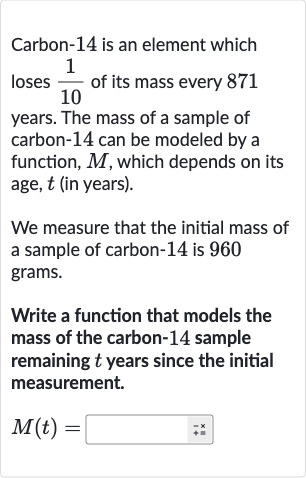AI tutor
Welcome to Bytelearn!
Let’s check out your problem:

Carbon is an element which loses of its mass every years. The mass of a sample of carbon can be modeled by a function, , which depends on its age, (in years).We measure that the initial mass of a sample of carbon is grams.Write a function that models the mass of the carbon- sample remaining years since the initial measurement.
Full solution
Q. Carbon is an element which loses of its mass every years. The mass of a sample of carbon can be modeled by a function, , which depends on its age, (in years).We measure that the initial mass of a sample of carbon is grams.Write a function that models the mass of the carbon- sample remaining years since the initial measurement.
- Identify Mass and Decay Rate: Identify the initial mass and the decay rate . The initial mass is given as grams. The decay rate is given as losing of its mass every years.
- Determine Decay Factor: Determine the decay factor . Since the sample loses of its mass every years, it retains of its mass every years. Therefore, the decay factor is .
- Write Exponential Decay Function: Write the exponential decay function.The function that models the mass of the carbon sample remaining after years is of the form .Here, '' is the initial mass, '' is the decay factor, and '' is the time in years.
- Adjust for Time Period: Adjust the decay factor for the time period.Since the decay happens every years, we need to adjust the exponent to reflect the passage of time in terms of -year periods.The adjusted decay function is .
- Substitute Values: Substitute the values of and into the function.Substitute for and for into the function ..
More problems from Write exponential functions: word problems
QuestionGet tutor help
QuestionGet tutor help
QuestionGet tutor help
QuestionGet tutor help
QuestionGet tutor help
QuestionGet tutor help
QuestionGet tutor help
QuestionGet tutor help
